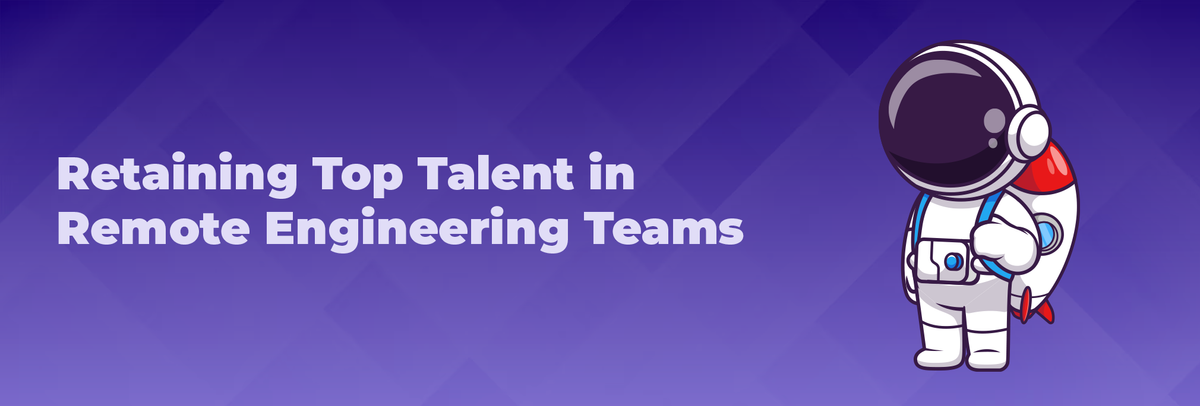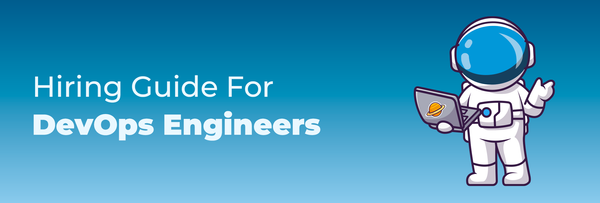Retaining Top Talent in Remote Engineering Teams

Are you losing sleep over the challenge of keeping your remote engineering stars shining bright?
In the ever-evolving world of work, employee retention is the ultimate puzzle to solve.
But let’s not make it another point to worry about!
Our blog is your treasure map to unlocking the secrets of employee retention in the digital age.
Here’s what you need to picture: your team thriving in a virtual ecosystem where passion meets purpose.
Intriguing, right?
Get ready to embark on a journey where we unravel the mysteries of employee retention strategies customized for remote engineering teams.
Stay tuned to discover the key to nurturing a workforce that not only stays but excels, employing effective employee retention tactics and programs!
Why is Remote Employee Retention Important?
In the realm of employee retention within remote work environments, the financial implications loom large.
A survey conducted by SHRM in 2022 unveiled an alarming statistic: turnover costs typically amount to 6 - 9 months of an employee’s salary.
To put this into perspective, if an employee earning $100,000 annually were to depart, the expenses of replacing them could soar to a staggering $50,000 - $75,000.
However, these figures only scratch the surface, failing to encapsulate the intangible losses such as decreased productivity, diminished employee morale, and tarnished reputation within the industry.
Securing Top Talent: Key Approaches for Retaining Remote Engineering Teams
Navigating the complexities of the modern workforce, let’s explore essential strategies to keep your remote engineering talent engaged and loyal.
- Develop Equitable Global Compensation Packages
Equitable global compensation is pivotal for retaining employees in today’s increasingly remote and globalized workforce.
Developing an equitable compensation package requires more than just assessing an employee’s skill and seniority level.
For employees working in different countries, multiple factors must be considered to ensure fairness and satisfaction.
Firstly, consider country-specific mandatory employer-provided benefits.
These can vary significantly from one region to another and must be factored into the overall compensation strategy.
Additionally, the cost of living in different locations affects salary expectations, necessitating adjustments to ensure that all employees can maintain a comparable standard of living.
Mandatory salary deductions, such as taxes and social security contributions, also differ by country and must be accounted for to provide equitable take-home pay.
Employee expectations regarding salary and benefits can vary widely based on cultural and economic factors.
Understanding and meeting these expectations is crucial for developing a compensation package that employees perceive as fair and attractive.
By incorporating these elements into your compensation strategy, you can develop a total rewards policy that encompasses bonuses, benefits, and additional incentives.
This policy should be designed to offer value and fairness, ensuring that all employees feel valued and fairly compensated.
Equitable compensation is a powerful mechanism for retaining a satisfied and loyal remote workforce.
Prioritizing fairness and transparency in your compensation practices will foster a positive work environment, enhance employee retention, and drive long-term success for your organization.
- Construct a Benefits Program to Retain Top Global Talent
Constructing a robust benefits program is essential for retaining top talent globally in an increasingly competitive and geographically dispersed workforce.
A well-designed benefits program goes beyond salary, offering a comprehensive package that addresses the diverse needs and expectations of employees worldwide.
Here’s how to build an effective benefits program:
- Conduct a Cost of Living Analysis
The cost of living varies significantly across different regions.
Conducting a thorough cost-of-living analysis helps you tailor benefits to ensure employees can maintain a comparable standard of living regardless of their location.
This can include housing allowances, transportation stipends, or cost-of-living adjustments.
- Offer Comprehensive Health and Wellness Benefits
Health and wellness are top priorities for employees.
70% of employees who participate in wellness programs have expressed greater job satisfaction compared to those who are not enrolled in their companies' programs
Moreover, employees are more inclined to endorse a company that prioritizes well-being initiatives as an excellent workplace.
Provide comprehensive health insurance that covers medical, dental, and vision care.
Additionally, consider wellness programs that promote physical and mental health, such as gym memberships, wellness apps, and mental health support.
Organizations boasting highly efficient health and wellness programs are 40% more inclined to report superior financial performance compared to those with less effective initiatives.
- Create a Professional Development Program
Top talent actively seeks opportunities for growth and development.
Organizations providing professional development initiatives experience a 34% increase in employee retention rates.
Moreover, 86% of employees indicated they would change jobs for better growth opportunities.
Invest in professional development programs that offer training, certifications, and career advancement opportunities.
This shows your commitment to their long-term success and helps keep them engaged and motivated.
- Implement Recognition and Reward Systems
Recognition is a powerful motivator.
Did you know that 71% of employees reported that they would be less inclined to leave their company if they received more frequent recognition?
Establish a framework for acknowledging and rewarding employee contributions.
This can include performance bonuses, employee of the month programs, and other incentive-based rewards that acknowledge hard work and dedication.
- Ensure Family-Friendly Benefits
Family-friendly benefits can significantly impact employee satisfaction.
Offer parental leave, childcare support, and family health insurance plans.
These benefits show that you value and support employees' families, which can increase loyalty and retention.
Lastly, ensure that employees are well-informed about the benefits available to them and how to utilize them.
Regularly review and update the benefits program to adapt to changing needs and market trends.
- Embrace Flexibility
Wondering how to improve employee retention?
Well, flexible work practices are a game-changer when it comes to retaining top global talent.
By offering remote options, flexible hours, and compressed workweeks, companies empower employees to balance work and life seamlessly.
This not only boosts job satisfaction but also attracts diverse talent from around the world.
Flexibility shows trust, fostering a culture of empowerment and innovation.
It's a win-win: employees thrive with autonomy, while organizations benefit from heightened engagement and retention.
Table 1 - Statistics on Flexibility and Employee Retention
- Create a DEI Global Workforce
According to McKinsey, companies recognized for their diversity and inclusivity are 35% more inclined to surpass their rivals in performance.
Creating a diverse, equitable, and inclusive global workforce is essential for talent retention.
By fostering an environment where all individuals feel valued and respected, organizations can reduce turnover rates and retain top talent.
Embracing diversity ensures that employees from various backgrounds feel included and appreciated, leading to higher job satisfaction and loyalty.
Additionally, promoting equity in opportunities and treatment enhances employee morale and commitment to the organization.
Inclusive workplaces not only attract diverse talent but also retain them by offering a sense of belonging and support.
This commitment to diversity and inclusion strengthens employee retention efforts and contributes to long-term organizational success.
Research shows that diverse teams make superior decisions in 87% of cases.
Point to Ponder: Just 23% of executive leadership positions, known as C-Suites, are occupied by women. (Source: Women in the Workplace)
Supercharge Your Business With Teamo: Access Top Talent Solutions Today!
Ready to elevate your business to new heights?
Embrace growth fearlessly with Teamo's cutting-edge talent solution!
Access top-tier, pre-screened software developers from emerging markets and seamlessly integrate them into your development team as remote powerhouses.
With Teamo, enjoy seamless integration, fast and affordable solutions, and the assurance of extensively vetted professionals driving your projects forward.
Get Started and revolutionize your development team with Teamo's game-changing talent solution!
FAQs
- How is the retention rate calculated for employees?
To gauge your retention rate, select the time frame you wish to evaluate, such as the previous year or quarter.
Then, collect two essential figures:
- The number of employees at the start of the designated period.
- The count of employees at the end of the period, excluding any new hires.
Once these numbers are gathered, utilize the following formula to compute your staff retention rate:
Retention Rate = ((Ending Employees - New Hires) / Starting Employees) × 100
For example, if you commenced a quarter with 200 employees and concluded it with 215 employees, with 25 new hires, the equation would be:
((215 - 25) ÷ 200) × 100 = 95%
It's vital to exclude new hires to ensure an accurate representation of your retention rate.
By subtracting new hires, you obtain a more precise measurement.
- What prompts top talent to leave an organization?
Top talent may choose to leave an organization for various reasons, including:
- Limited opportunities for career advancement or professional growth within the company.
- Dissatisfaction with the organizational culture, values, or workplace environment.
- Issues with management style, lack of effective leadership, or poor communication.
- Feeling undervalued or unappreciated for their contributions.
- Seeking better compensation, benefits, or perks elsewhere.
- Burnout or excessive workload without adequate support or work-life balance.
- Lack of alignment between personal values and the organization's mission or practices.
- Better opportunities for development or advancement are offered by competitors or other companies.
- Inadequate training or resources to support their professional goals and aspirations.
- Desire for a change of scenery, location, or industry.




